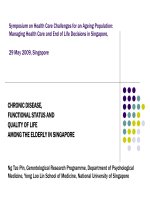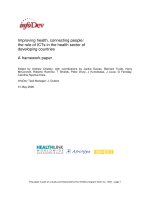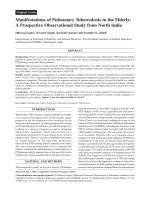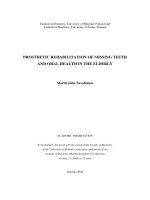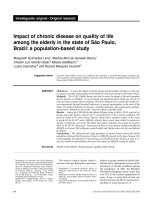Compression of morbidity in the elderly pot
Bạn đang xem bản rút gọn của tài liệu. Xem và tải ngay bản đầy đủ của tài liệu tại đây (210.53 KB, 6 trang )
Compression of morbidity in the elderly
James F. Fries*
Stanford University School of Medicine, 1000 Welch Road, Suite 203, Palo Alto, CA 94304-5755, USA
Abstract
The Compression of morbidity paradigm envisions reduction in cumulative lifetime morbidity through primary prevention by
postponing the age of onset of morbidity to a greater amount than life expectancy is increased, largely by reducing the lifestyle
health risks which cause morbidity and disability. Recent data document slowly improving age-speci®c health status for seniors,
indicate that postponement of the onset of disability by at least 10 years is feasible, and prove eectiveness of some lifestyle
interventions by randomized controlled trials. Human aging is increasingly represented by frailty, with declining reserve function
of many organ systems, including the immune system. Enhancement of immune function in this setting raises medical, ethical,
and social issues which are sometimes in con¯ict. # 2000 Elsevier Science Ltd. All rights reserved.
Keywords: Compression of morbidity; Aging; Primary prevention
The health of persons over 65 years of age is a medi-
cal problem in the developed nations. Over 80% of all
illness, morbidity, mortality, and medical costs are
concentrated in the years after age 65. The illness bur-
den is mostly made up of chronic illness, complicated
by the frailty of increasing age. In this century we
have seen a transfer of the illness burden from the
acute infectious diseases prevalen t in 1900 to chronic
disease by mid-century, followed by a decline in major
chronic illnesses, and now with a slow transition from
chronic disease per se to the associated problems of
aging [1].
1. An overview of the aging process
1.1. Mortality changes over time
Changes in survival curves in developed nations
over this century are instructive, since they lead us
beyond a simplistic, if popular, notion of ever-increas-
ing life expectancy. Life expectancy from birth is
aected most strongly by changes in infant mortality
rates and in deaths in early life. Successive survival
curves (Fig. 1) have become more rectangular, as
marked reduction in deaths at early ages ¯atten the in-
itial part of the curve. There are now few deaths prior
to age 50 or 60. At the same time, the downslope of
the curves has become steeper, although the insertion
point has changed little [2]. A natural barrier to bio-
logic longevity may be visualized through these succes-
sive curves. In the United States, life expectancy from
birth has increased from 47 to 75 years. However, life
expectancy from advanced ages has changed relatively
little. Since 1980, life expectancy for females from age
65 has increased only by 0.5 years. Almost unnoticed
has been a striking occurrence; life expectancy for bot h
sexes from age 85, 6.1 years, has not changed signi®-
cantly during the past 20 years [3]. With the increasing
size of su ccessive birth cohorts and with increased sur-
vival to age 65 or age 85 the absolute numbers of
senior citizens will increase markedly in coming years,
while life expectancy for the average senior will
increase little.
Vaccine 18 (2000) 1584±1589
0264-410X/00/$ - see front matter # 2000 Elsevier Science Ltd. All rights reserved.
PII: S0 2 6 4 - 4 1 0 X ( 9 9 ) 0 0 4 9 0 - 9
www.elsevier.com/locate/vaccine
* Tel.: +1-650-723-6003; fax: +1-650-723-9656.
E-mail address: j@leland.stanford.edu (J.F. Fries).
1.2. Declines in organ reserve function with age
Data from longitudinal studies of aging show a con-
sistent decline in the maximum function of the various
organs with age, the decline being essentially linear at
a rate of 1.5% per year after age 30 (Fig. 2). Data on
maximal performance, such as world record marathon
times, similarly show a nearly linear decline with age
at the same rate from age 30 to age 80 [2].
Physiologic normal values, however, as represented
by the central tube in Fig. 3, remai n constant with
increasing age. Normal pH, blood chemistry, white cell
count, and other homeostatic values do not vary over
the lifespan, representing the internal physiologic en-
vironment essential for cellular function. However,
with the linear decrease in organ reserve in multiple
organs the ability to respond physiologically to a per-
turbation decreases exponentially, represented by the
decreasing area of the polygon in the ®gure. As a
result, mortality rates increase exponentially, with a
doubling of mortality rates each 8 years after age 30
[2].
With these realities of human aging come some
paradoxes, particularly in the context of emerging
scienti®c advances, some of which are more fully ela-
borated in this volume. Decline in organ reserve is
inevitable, yet we can increase organ reserve quite
readily, at almost any age. For example, an increase in
exercise can increase cardiopulmonary reserve very
substantially, even at advanced ages [4,5].
1.3. Enhanced personal autonomy and modi®able
determinism
In philosophic writings, a classical con¯ict has been
between the advocates of free will and those of deter-
minism, and this con¯ict now exists in modern dress.
Determinism is represented by molecular genetics, with
the notion that your health over a lifespan is ulti-
mately determined only by your genes. Free will is rep-
resented by the advocates of health promotion, seeking
voluntary changes in behavioral risk factors, such as
lack of exercise, cigarette smoking, obesit y, and dietary
fat, which can enhance organ reserve, preserve func-
tion, and extend life. In this view, health requires that
you take care of yourself. The tension between these
two paradigms is complicated by the new science,
where the role of telomerase, apoptosis, the growth of
pluri-potential stem cell lines, and other developments
remains to be determined.
Fig. 1. The rectangularization of survival curves. Successive curves,
at 20 year intervals, illustrate (a) the ¯attening of the early part of
the curves from decreases in premature deaths, (b) the steepening of
the downslope as natural life limits are approached, and (c) the
nearly constant insertion site of the curves.
Fig. 2. Declining reserve organ function with age in several organ
systems; decline is essentially linear and similar for dierent organs.
Fig. 3. Declining ability to return to the homeostatic state (rep-
resented by the tube) after a perturbation. The polygon area rep-
resents the multiple organ system reserve of the organism and
decreases exponentially with age.
J.F. Fries / Vaccine 18 (2000) 1584±1589 1585
2. The Compression of Morbidity
2.1. The hypothesis and the paradigm
The Compression of Morbidity hypothesis was
introduced in 1980 [1] and has become the dominant
paradigm underlying health improvement programs
and policies directed at more successful aging [6,7].
Most morbidity results from chronic processes and is
concentrated in the years prior to death. The goal is
the compression of mo rbidity between its time of
onset, currently averaging 55 years, and the age of
death, currently averaging 75 years, as diagrammed in
Fig. 4. A crescendo of increasing morbidity occurs, on
average, over this period. With social and scienti®c
progress it is likely that both the age of onset of in®r-
mity and the age at death will increase over time. At
issue is the relative movement of the two points. If
mortality decreases predominate there may be more
morbidity in a typical life, the so-called ``failure of suc-
cess'' [8,9], as shown in the second line of the ®gure. If
postponement of the age of onset of morbidity pre-
dominates, then morbidity is compressed and the aver-
age illness burden is less, the period of adult vigor is
prolonged, life quality is improved, and the need for
medical care and associated costs may be reduced.
For many, the ideal life is one vigorous and vital
over the life span, with a terminal collapse of physical
and mental function limited to a few months or years
immediately preceding death [2]. A central issue, when
considering the eventual impact of new scienti®c dis-
coveries, is whether they may add health or add illness
to the average life. If morbidity is compres sed by a
new advance then the advantage is clear; if the process
of dying is prolonged then major ethical issues arise
[10].
2.2. Trends in morbidity compression
Over the past 20 years there has been some com-
pression of morbidity in the elderly, even without
health policies directed at morbidity compression
[11,12]. The major chronic illnesses, including heart
disease, cancer, and stroke, are about 70% preventa-
ble. The true causes of death are not the chronic dis-
eases but the underlying causes of these diseases,
which are led by cigarette smoking, sedentary living,
obesity, and diets high in saturated fat and low in
complex carbohydrates [13]. The potential for post-
ponement of morbidity is now much better under-
stood.
Freedman and Martin [14], among others, have
shown signi®cant age-speci®c functional improvement
in seniors over a recent seven-year period. Cross-sec-
tional studies have suggested compression of morbidity
in favored groups, such as those with higher levels of
education [15], higher socio-economic class [16], and
those with fewer lifestyle health risks. Daviglus et al.
[17] showed substantial decreases in Medicare costs for
those with few health risk factors in mid-life. Reed et
al. [18] related healthy aging to prospectively deter-
mined health risks. Clearly, behavioral health risks
makes a very major contribution to both morbidity
and mortality. Selected medical advances such as total
joint replacement and cataract extraction, or any treat-
ment which makes a major contribution to life quality,
also contributes to the compression of morbidity. The
central measure of success of the compression of mor-
bidity is reduction in the average cumulative lifetime
morbidity [19].
3. How long may the onset of morbidity be postponed?
3.1. Estimating postp onement of morbidity
Our research group has been prospectively following
substantial numbers of aging seniors in two cohorts
longitudinally over the past 16 years to identify the
factors which postpone onset of morbidity, the magni-
Fig. 4. Compression of Morbidity. The top line provides a graphic
estimate of current lifetime morbidity, disability, or cost, expressed
as a shaded area between onset of disability at an average age of 55
years and an average age of death of 75 years. Possible future scen-
arios are shown below. The second line represents the extension of
morbidity if life expectancy is increased but the onset age of morbid-
ity is not. The third shows compression of morbidity if the onset age
of morbidity rises more rapidly than does the life expectancy.
J.F. Fries / Vaccine 18 (2000) 1584±15891586
tude of the postponement, and the eects of lifestyle
health risks upon cumulative lifetime disability. We
use disability as a de®nable and measurable surrogate
for morbidity and cumulative disabi lity over the elder
years as a surrogate for cumula tive lifeti me disability
[5,19].
3.2. The University of Pennsylvania Study
In the University of Pennsylvania Study we follow
1741 university attendees studied in 1939 and 1940,
surveyed again in 1962, and followed annually since
1986. Health risk strata were developed for persons at
high, moderate, or low risk, based upon cigarette
smoking, body mass index, and lack of exercise, and
assigned by risk status in 1962 (average age 43 years).
Cumulative disability from 1986 to 1994 (average age
75 years) served as the surrogate for lifetime disability.
Persons with high health risks in 1962 or in 1986 had
twice the cumulative disability of these in the low risk
strata. Deceased low risk subjects had only one-half
the cumulative lifetime disability of high risk subjects
and also had only one-half the amount of disability in
the last one or two years of life. The same results
obtained in males and in females, and in those without
disability in 1962 and 1986. This 100% decrease in dis-
ability rates was oset only partially by a 50%
decrease in mortality rates in the high risk strata,
demonstrating compres sion of morbidity. Onset of dis-
ability (Fig. 5) was postponed by 7.75 years in the low
risk stratum as compared with the high risk stratum
[19].
3.3. The Precursors of Arthritis Study
In the Precursors of Arthritis Study we have fol-
lowed 537 senior runners and vigorous exercisers with
423 age-matched community controls. We controlled
for self-selection bias by a longitudinal ``intention to
treat'' study since 1984, by separate analyses for gen-
der, by accounting for pre-study dropouts by including
all who had ever begun an exercise program at any
point in life, by separately analyzing those without in-
itial disabi lity, and by controlling for joint X-ray sta-
tus, history of arthritis, and other factors [5, 20].
Present data show the exercising group to have less
Fig. 5. Progression of disability over time in low, medium, and high risk groups from the University of Pennsylvania study. The average post-
ponement of disability in the low risk group as compared with the high risk group is 7.75 years.
J.F. Fries / Vaccine 18 (2000) 1584±1589 1587
than one-half the cumulative disability of the sedentary
controls and this major dierence between groups
actually increased over the 13 years of observation.
Results held for men and women, those without initial
disability, and for all of the other subgroups. The pro-
portion of those disabled was also reduced by more
than on-half in the exercise groups. The postponement
of disability for the exercising group was 8.7 years for
minimum disability and approx. 12 years for higher
levels of disability.
4. Reduction in need and demand for medical service
Epidemiologic studies of associations, no matter
how strong and consistent, ultimately require random-
ized study of interventions for proof of causality, and
these are now available. Health promotion programs
in senior populations directed at risk prevention,
health improvement, and medical cost reduction have
been studied in a number of large and well performed
randomized trials, with positive results. The Bank of
America randomized study of 4500 retired subjects
reduced risks by 12% in the intervention groups in the
®rst year compared with controls and reduced medical
care and costs, as con®rmed by a study of medical
claims [22], by even a greater percentage. The Califor-
nia Public Employment Retirement System study [23],
involved 57,000 subjects in a 1-year randomized trial
with similarly dramatic results con®rmed by claims
data endpoints. Randomized studies of self-manage-
ment programs for chronic diseases such as arthritis
[24] and Parkinson's Disease [25] have had similarly
positive results. Carefully designed high quality health
improvement programs have now been proven eective
and cost-eective both preventing illness and reducing
medical need [26].
5. Issues for contemplation
The human aging process, when not prematurely
stopped by trauma or disease, moves towards multiple
organ system frailty [6,7,9]. The immediate cause of
death shifts from external towards intrinsic factors.
The formally assigned ``cause of death'' becomes
increasingly irrelevant compared with the underlying
frailty, the inability of the aging organism to withstand
even a minor perturbation. Frailty is like an old cur-
tain rotted by the sun, where an attempt to repair a
tear in one place is followed by a tear in another.
In a similar context, William Osler considered pneu-
monia to be the ``old mans' friend'', terminating the
in®rmities of frailty. In¯uenza epidemics result in an
increase in death rates, but they are followed by a 6-
month period of death rates which are actually below
expected baselines. Pneumovax and in¯uenza vaccines
can prevent a number of speci®c perturbations and as-
sociated attributable deaths, but only in the context of
multi-organ frailty. The ultimat e health bene®ts of suc-
cessful interventions in the terminally frail may prove
in substantial part illusory when so many competing
risks remain.
Age-associated declines in the immune and in¯am-
matory responses have been well de®ned. Similar
declines occur in other organ systems. What would be
the full range of eects if declines in the immune and
in¯ammatory systems were prevented or reversed in
the setting of declines in other organ systems with
multi-organ failure and increased frailty? Is there an
important signal in the app arently accelerated aging of
Dolly, the telomerase-impaired cloned sheep? The cen-
tral question: would enhanced immune responsiveness
increase health or increase morbidity? Answers to such
questions are clearly speculative, but it seems that one
answer might carry a bit of a paradox with it; that
improved immune responsiveness might be construc-
tive in terms of decreasing morbidity if achieved prior
to terminal multiple organ frailty, but might increase
lifetime morbidity, albeit only slightly, if achieved only
shortly before the time of natural death.
Acknowledgements
This paper was supported by a grant from the
National Institutes of Health (AR43584) to ARAMIS
(Arthritis, Rheumatism, and Agin g Medical Infor-
mation System).
References
[1] Fries JF. Aging, natural death, and the compression of morbid-
ity. N Engl J Med 1980;303:130±5.
[2] Fries JF, Crapo LM. Vitality and aging. San Francisco:
Freeman, 1981.
[3] Kranczer S. US life expectancy. Statistical Bulletin
1997;Oct(Dec):8±14.
[4] Stewart AL, King AC, Haskell WL. Endurance exercise and
health-related quality of life in 50±65 year-old adults.
Gerontologist 1993;33:782±9.
[5] Fries JF, Singh G, Morfeld D, et al. Running and musculoske-
letal pain with age: a six-year longitudinal study. Arthritis
Rheum 1996;39:64±72.
[6] Fries JF. Compression of morbidity: Near or far? Milbank
Mem Fund Q 1990;67(2):208±32.
[7] Fries JF. Compression of morbidity 1993: Life span, disability,
and health care costs. Facts Research Gerontol 1993;7:183±90.
[8] Gruenberg EM. The failure of success. Milbank Q 1997;55:3±
34.
[9] Olshansky SJ, Rudberg MA, Carnes BA, et al. Trading o
longer life for worsening health: The expansion of morbidity hy-
pothesis. J Aging Health 1991;3(2):194±216.
J.F. Fries / Vaccine 18 (2000) 1584±15891588
[10] Verbrugge LM. Longer life but worsening health? Trends in
health and mortality of middle-aged and older persons.
Milbank Q 1984;62:475±519.
[11] Nusselder WJ, Mackenbach JP. Rectangularization of the survi-
val curve in the Netherlands, 1950-1992, Gerontologist
1996;36773±82.
[12] Campion EW. Aging better. N Engl J Med 1998;338:1064±6.
[13] Mcginnis JF, Foege W. Actual causes of death in the United
States. JAMA 1993;270(19):2207±12.
[14] Freedman VA, Martin LG. Understanding trends in functional
limitations among older Americans. Am J Pub Health
1998;88(10):1457±62.
[15] Leigh JP, Fries JF. Education, gender and the compression of
morbidity. Int J Aging Hum Dev 1994;39:233±46.
[16] House JS, Kessler RC, Herzog AR, et al. Age, socioeconomic
status, and health. Milbank Mem Fund Q 1990;68:383±
411.
[17] Daviglus ML, Liu K, Greenland P, et al. Bene®t of a favorable
cardiovascular risk-factor pro®le in middle age with respect to
medicare costs. N Engl J Med 1998;339(16):1122±9.
[18] Reed DM, Foley DJ, White LR, et al. Predictors of healthy
aging in men with high life expectancies. Am J Pub Health
1998;88(10):1463±8.
[19] Vita AJ, Terry RB, Hubert HB, et al. Aging, health risks, and
cumulative disability. N Engl J Med 1998;338:1035±41.
[20] Fries JF, Singh S, Morfeld D, et al. Running and the develop-
ment of disability with age. Ann Intern Med 1994;121(7):502±9.
[22] Fries JF, Bloch DA, Harrington H, Richardson N, Beck R.
Two-year results of a randomized controlled trial of a health
promotion program in a retiree population: the Bank of
America study. Am J Med 1993;94:455±62.
[23] Fries JF, Harrington H, Edward R, Kent LA, Richardson N.
Randomized controlled trial of cost reductions from a health
education program: the California Public Employees'
Retirement System (PERS) study. Am J Health Promotion
1994;8:216±23.
[24] Fries JF, Carey C, McShane DJ. Patient education in arthritis:
Randomized controlled trial of a mail-delivered program. J
Rheumatol 1997;24(7):1378±83.
[25] Montgomery Jr EB, Leiberman A, Singh G, Fries JF. Patient
education and health promotion can be eective in Parkinson's
Disease: A randomized controlled trial. Am J Med 1994;97:429±
35.
[26] Fries JF, Koop CE, Sokolov J, Beadle CE, Wright D. Beyond
health promotion: reducing need and demand for medical care.
Health Aairs 1998;17(2):70±84.
J.F. Fries / Vaccine 18 (2000) 1584±1589 1589




